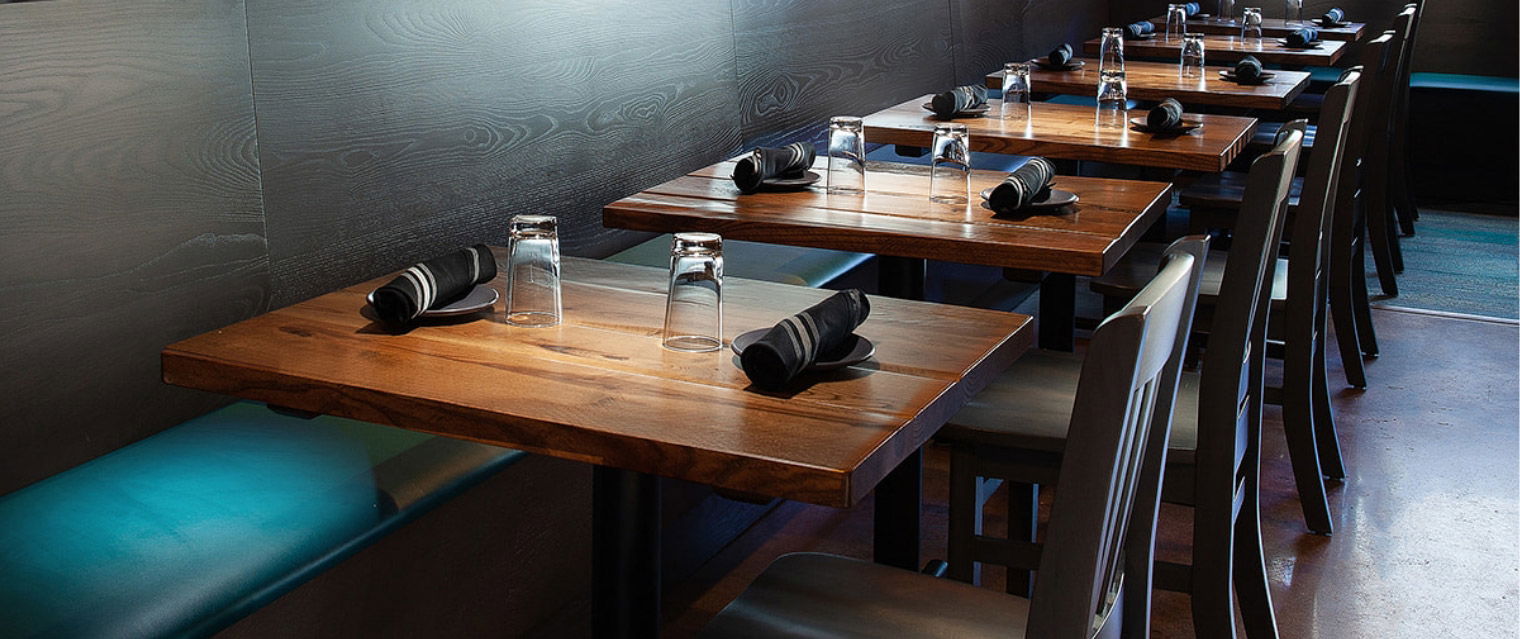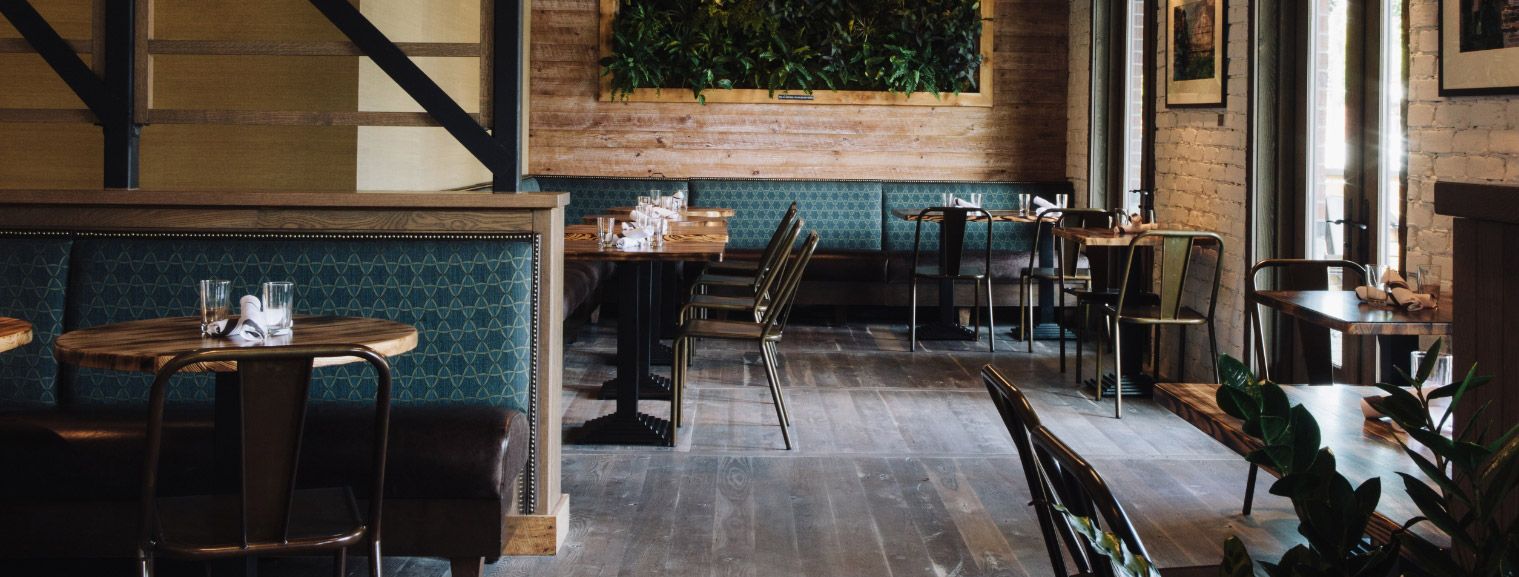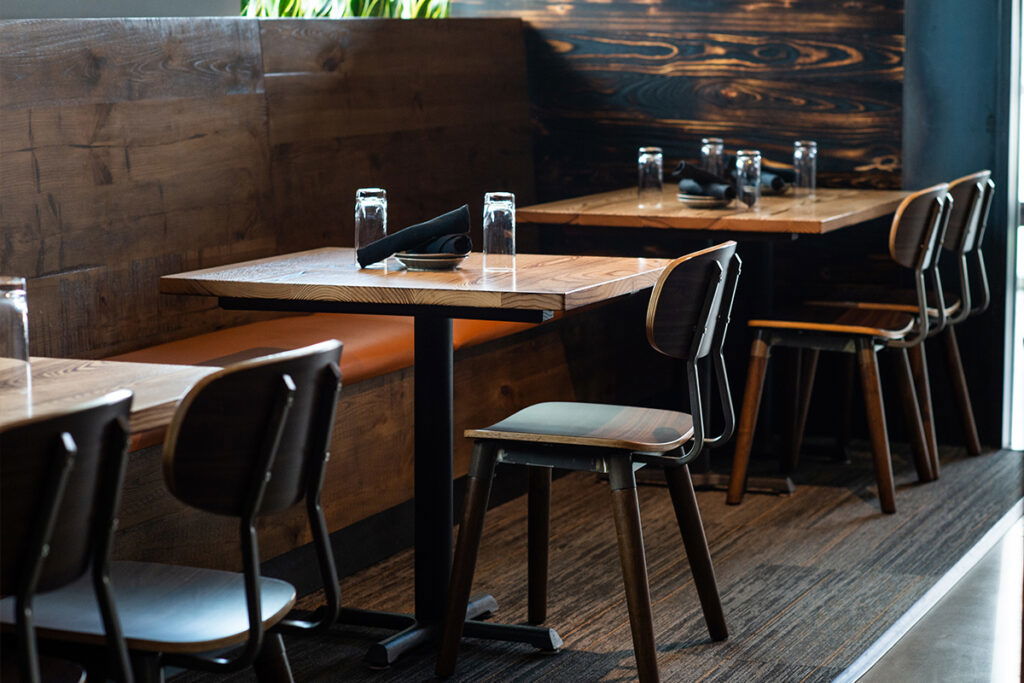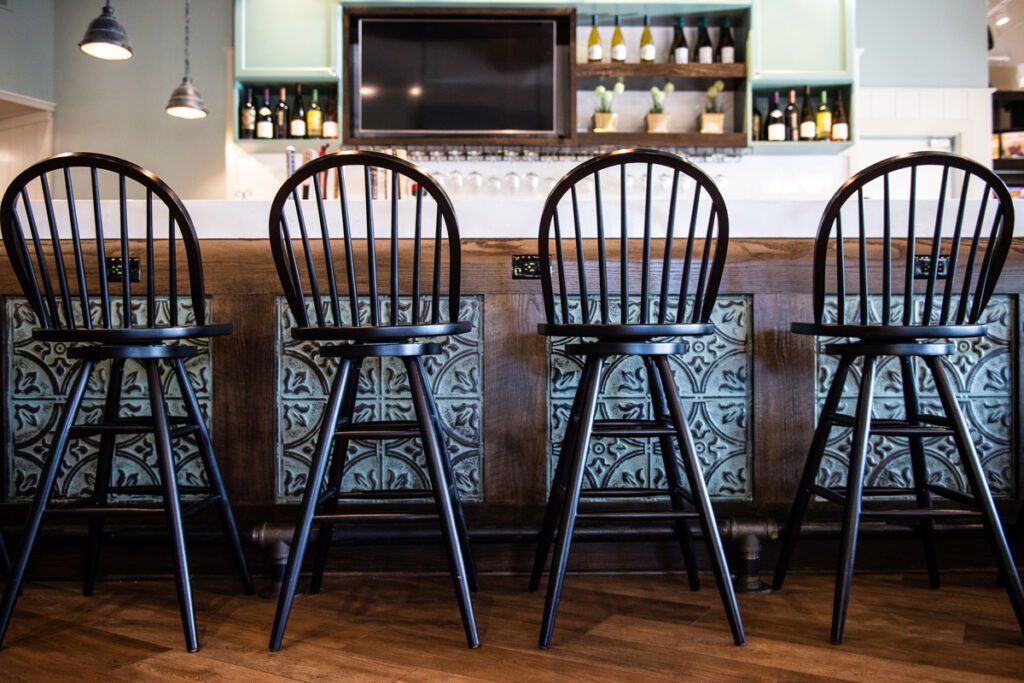A well-designed restaurant interior can make all the difference in the appearance of your business. Custom restaurant furniture is a great option to get the look and feel you want.
If you’re looking to maximize the look and feel of your restaurant interiors, consider these tips.

1) Choose the Right Materials for Your Restaurant Interior
When it comes to selecting the materials for a restaurant or bar, it is a delicate balance between durability and aesthetics.
Oftentimes, mass-market commercial furniture solely prioritizes practicality, leaving much to be desired in terms of an attractive design. On the other hand, materials that can’t stand up to regular cleaning and maintenance aren’t suitable either.
But with the right approach, you can incorporate ideal materials that look great and perform well under pressure.
A few things to keep in mind:
- When you’re weighing your options, consider how easy various materials will be to clean. For example, can a tabletop endure regular cleaning and sanitizing without wearing down too quickly?
- What effect will spillage have on the types of materials you’re looking at? Beverages, sauces, and grease can wreak havoc on restaurant furniture, particularly upholstery. Although a certain amount of wear and tear is to be expected, opting for suitable materials can make a big difference.
- Think about longevity and how it factors into the “big picture,” then consider how different types of materials will measure up to your needs. There are many factors that can affect how long materials last in your restaurant, including sunlight exposure, use, indoor vs. outdoor placement, and more.
- What kind of brand identity are you aiming to create? Is your brand concept defined by luxury and opulence, or is casual comfort more your style? Pinpointing these key characteristics will make it easier to find materials to match.
- How do you expect the furniture materials to fit in with other design elements? As any designer knows, creating a sense of cohesiveness is essential.

2) Choose the Right Furniture
Furniture is perhaps one of the most important aspects of your restaurant, and it can either contribute to or detract from the atmosphere and customer experience. Think of furniture as a way to set the “tone” for your business — and a crucial part of making an excellent first impression on your guests.
The best restaurant furniture for any interior largely depends on the concept of the restaurant itself, which is expressed through the menu and food, design, and decor. Even the name of a restaurant is a part of its overarching concept. Long before you can begin searching for custom restaurant furniture, you need to have a firm grasp on your restaurant’s concept. This encompasses how you want the space to look and how you want guests to feel when they are in your restaurant. From aspects as obvious as color scheme to customer staying time, there are many elements to consider.
From there, you can begin to think about the different styles of restaurant furniture. Furniture styles should reflect the style and ambiance of a restaurant, as well as serve the basic needs and expectations of guests. Usually, the type of restaurant dictates the ideal style. For example:
- A fast-food restaurant needs to accommodate a significant flow of guest traffic, making durability imperative. And because most fast food establishments aim to serve a high number of customers at a time, comfort isn’t necessarily of the utmost importance — because guests won’t typically be staying very long.
- Casual dining furniture is typically suitable for family-friendly, relatively affordable restaurants. Again, durability is a must, but so is comfort. Additionally, specific pieces such as high chairs and booster seats are often key to these restaurants’ target market.
- Cafe furniture often accommodates guests that are seeking a warm, welcoming environment where they can eat, drink, work, and gather. A variety of seating options, including tables and chairs, booths, and even couches, can serve the diverse needs of cafe guests. Space-saving restaurant furniture design is also often a priority.
- Bar furniture can range from ultra-casual to high-end, depending on the desired ambiance. Generally, bar stools are a staple piece. It’s not unusual for designers to opt for easy-to-wipe materials for bars, although upscale establishments may prioritize aesthetics instead.
- Cafeteria furniture typically needs to check a variety of boxes, with durability and compact design being top goals. Having the flexibility to accommodate various group sizes is also a plus when searching for cafeteria furniture pieces.
Of course, the amount of space available also plays a pivotal role in the furniture selection process. Efficient use of space is always a useful feature in any restaurant’s design, but particularly so for those with a conservative footprint. Both guests and staff should be able to easily maneuver around the space, which means that careful planning will be involved.
Functionality is another core component of well-suited restaurant furniture. It doesn’t matter how beautiful a piece may be if it doesn’t properly function within your space. For example, a set of stunning dining chairs may look beautiful, but if they are terribly uncomfortable, they are not a good investment.
Finally, your budget will be a guiding force in the decision-making process. While the cheapest restaurant furniture isn’t typically the highest quality, there are affordable options that will meet your standards. By going the custom route, you can make decisions to make the most of your budget while still fulfilling your overall vision.

3) Use Contrasting Colors to Enhance the Appearance of Your Restaurant Interior
The psychology of color is an often-discussed topic in business, particularly in the restaurant industry. Certain colors are often associated with specific effects; for example, natural tones like green and brown can convey a calming atmosphere, while vibrant shades like orange often inspire cheerful feelings. Instead of taking aim at one emotion, the ideal restaurant color schemes incorporate appropriately contrasting shades to achieve maximum benefit.
When implemented carefully, contrast can create visual interest. For example, you might pair upholstered booths in a rich eggplant shade with a light interior paint color to draw guests’ attention to seating areas and anchor the design. Or, vivid shades of yellow and red can provide a pop of color against white tabletops, reminiscent of 1960s pop art. However, too much contrast can have a negative, somewhat chaotic effect.
Remember that there are many elements that will contribute to the appearance of the interior, ranging from the finish of wood tabletops to the metal legs of your barstools. As you assemble a selection of restaurant furniture, regularly “step back” to confirm that there is a harmonious balance of contrast and cohesion.

4) Create a Sense of Space Within Your Restaurant Interior
Regardless the type or size of a restaurant, there are clearly defined zones that each serve a unique purpose. Aside from the clear division between the dining area and the kitchen, you should also strive to develop a certain level of organization within the areas that guests will occupy.
These various spaces might include:
- Seating areas that create suitable spaces for solo diners, duos, and groups
- A bar area that encourages social interaction
- A comfortable, welcoming waiting area
- Special rooms or areas for large groups and/or private events
In addition to contributing to the experiences you want guests to have, these spaces should also be organized in a way that supports an obstacle-free path of movement. Open, empty space is just as valuable as the areas occupied by furniture (and thus, people), and planning for both is key. As you select restaurant furniture, be mindful of how you can achieve both of these goals at the same time.
For example:
- Plush, high-backed booths that offer a sense of intimacy and privacy
- Tabletops that provide just the right amount of usable space
- Tables and chairs that can be easily moved to accommodate various group sizes
Ultimately, your goal should be to select furniture that allows you to make optimal use of the space by balancing business needs and customer wants.

5) Understand How Custom Restaurant Furniture Improves the Environment
Although mass-market commercial furniture may seem appealingly convenient, it often doesn’t permit your restaurant to reach its full potential. When you think about the value of investing in custom-manufactured furniture, the lasting benefits become clear.
Custom restaurant furniture makes it possible to flawlessly execute your design in a way that aligns with your interior style and overall brand. There are no compromises necessary, so you don’t have to settle for pieces that are “good enough.” Guests will enter your restaurant and be able to immediately discern what makes your restaurant unique from your competitors.
Also, choosing custom furniture makes it far easier to develop a cohesive space. Because you maintain complete control over every detail, there’s no need to force various pre-made pieces to fit together. This consistency can be felt both in how a restaurant functions and how it looks.
Above all, a better restaurant environment results in happier guests — which translates into return visits, positive feedback, a strong reputation, and increased sales and profits. In this way, your restaurant’s furniture has a direct and powerful impact on the success of your business.


